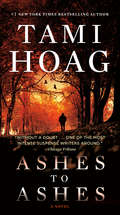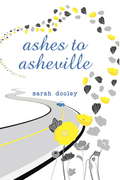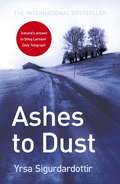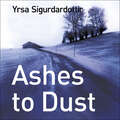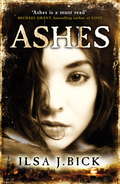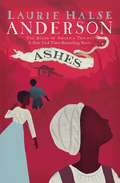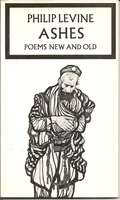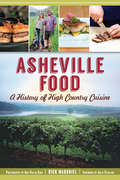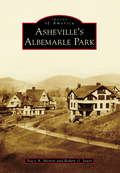- Table View
- List View
Ashes to Ashes (Experiment in Terror #12)
by Karina HalleThey are each other's anchors . . . and the storm is far from over. It's been two months since Perry Palomino and Dex Foray's relationship reached a new turning point, two months since Perry started a new life in Seattle, and two months since their Experiment in Terror show took on a new partner, ex-Wine Babe Rebecca Sims, and a newfound level of success. But whenever there is light in their lives, the madness still has a way of coming back in.When the team is sent back to the stormy Oregon coast to investigate a haunted school, Perry wants to use the opportunity to reconnect with her family and reintroduce Dex into their lives. Only Perry's not the only one who's reaching out - her grandmother Pippa has started appearing to her with disturbing warnings and Perry's presence at the school has ignited a chilling new wave of supernatural phenomenon. Once used a century ago as a sanatorium to house children dying of tuberculosis, the school's past residents are slowly coming back to life and with one thing on their mind: They want someone to play with, someone to join them. Forever.Even when dead, some children get whatever they want.And they want Perry.
Ashes to Ashes (Francis Hancock Mystery 3): A page-turning World War Two crime thriller
by Barbara NadelAs London burns, an unlikely hero unearths a series of brutal murders...Ashes to Ashes is the third novel in the acclaimed Francis Hancock World War Two crime series by Barbara Nadel. Perfect for fans of Martin Walker and Maureen Jennings. 'A great depiction of the period and a touchingly involuntary new sleuth' - Guardian As the German Luftwaffe bomb the capital, undertaker Francis Hancock suddenly finds himself caught up in the middle of a terrifying abduction plot.It's 29 December, 1940, the night that Hitler has chosen to destroy London under a barrage of flaming incendiary bombs. Their main target - St Paul's cathedral - is where Hancock is sheltering from the onslaught. But the First World War veteran doesn't just have bombs to contend with; a young girl, who was also sheltering in the cathedral, has vanished. Then some of those charged with protecting the building are brutally murdered. Hancock must face his own demons and fears in his struggle to catch those responsible and bring them to justice...What readers are saying about Ashes to Ashes:'The details of people's ordinary lives adds so much depth to the story''The tale covers madness, loyalty, patriotism, priorities, faith - all the deep stuff Barbara Nadel tackles so well''Barbara Nadel is a seriously perceptive, interesting writer'
Ashes to Ashes, Crust to Crust: A Deep Dish Mystery (Deep Dish Mysteries #2)
by Mindy QuigleyAshes to Ashes, Crust to Crust is the second book in Mindy Quigley's delectable Deep Dish Mystery series, set in a Wisconsin pizzeria.Newly single pizzeria owner Delilah O’Leary is determined to keep her restaurant afloat in the picturesque resort town of Geneva Bay, Wisconsin. To boost her bottom line, she sets her sights on winning the hefty cash prize in the town’s annual “Taste of Wisconsin” culinary contest. In her corner, she’s got her strong-willed, “big-boned” cat Butterball, her wisecracking BFF, her cantankerous great-aunt, and a nearly-flawless recipe for Pretzel Crust Deep-Dish Bratwurst Pizza. But while Delilah and her team have been focused on pumping out perfect pizza pies, her ex-fiancé has cozied up to a new squeeze, juice bar owner Jordan Watts—Delilah’s contest rival.When one of Jordan’s juice bar customers is poisoned by a tainted smoothie, Delilah lands deep in the sauce. Accusations fly, suspects abound, and a menacing stranger turns up with a beef over some missing dough. Between kale-juicing hipsters and grudge-bearing celebrity chefs, Delilah must act quickly before another one bites the crust.
Ashes to Ashes: A Novel (Kovac / Liska #1)
by Tami Hoag"Without a doubt . . . one of the most intense suspense writers around."--Chicago Tribune "[Tami Hoag] demonstrates just why she has become one of the hottest names in the suspense game. Bottom line: Leaves competition in the dust."--People He performs his profane ceremony in a wooded Minneapolis park, anointing his victims, then setting the bodies ablaze. He has already claimed three lives, and he won't stop there. Only this time there is a witness. But she isn't talking. Enter Kate Conlan, former FBI agent turned victim/witness advocate. Not even she can tell if the reluctant witness is a potential victim or something more troubling still. Her superiors are interested only because the latest victim may be the daughter of Peter Bondurant, an enigmatic billionaire. When Peter pulls strings, Special Agent John Quinn gets assigned to the case. But the FBI's ace profiler of serial killers is the last person Kate wants to work with, not with their troubled history. Now she faces the most difficult role of her career--and her life. For she's the only woman who has what it takes to stop the killer . . . and the one woman he wants next. "You'll want to lock the doors while you're reading."--Minneapolis Star Tribune "An up-all-night read."--The Detroit NewsFrom the Paperback edition.
Ashes to Ashes: A page-turning World War Two crime thriller (Francis Hancock Mystery #3)
by Barbara NadelAs London burns, an unlikely hero unearths a series of brutal murders...Ashes to Ashes is the third novel in the acclaimed Francis Hancock World War Two crime series by Barbara Nadel. Perfect for fans of Martin Walker and Maureen Jennings. 'A great depiction of the period and a touchingly involuntary new sleuth' - Guardian As the German Luftwaffe bomb the capital, undertaker Francis Hancock suddenly finds himself caught up in the middle of a terrifying abduction plot.It's 29 December, 1940, the night that Hitler has chosen to destroy London under a barrage of flaming incendiary bombs. Their main target - St Paul's cathedral - is where Hancock is sheltering from the onslaught. But the First World War veteran doesn't just have bombs to contend with; a young girl, who was also sheltering in the cathedral, has vanished. Then some of those charged with protecting the building are brutally murdered. Hancock must face his own demons and fears in his struggle to catch those responsible and bring them to justice...What readers are saying about Ashes to Ashes:'The details of people's ordinary lives adds so much depth to the story''The tale covers madness, loyalty, patriotism, priorities, faith - all the deep stuff Barbara Nadel tackles so well''Barbara Nadel is a seriously perceptive, interesting writer'
Ashes to Ashes: America's Hundred-Year Cigarette War, the Public Health, and the Unabashed Triumph of Philip Morris
by Richard KlugerNo book before this one has rendered the story of cigarettes -- mankind's most common self-destructive instrument and its most profitable consumer product -- with such sweep and enlivening detail. Here for the first time, in a story full of the complexities and contradictions of human nature, all the strands of the historical process -- financial, social, psychological, medical, political, and legal -- are woven together in a riveting narrative. The key characters are the top corporate executives, public health investigators, and antismoking activists who have clashed ever more stridently as Americans debate whether smoking should be closely regulated as a major health menace. We see tobacco spread rapidly from its aboriginal sources in the New World 500 years ago, as it becomes increasingly viewed by some as sinful and some as alluring, and by government as a windfall source of tax revenue. With the arrival of the cigarette in the late-nineteenth century, smoking changes from a luxury and occasional pastime to an everyday -- to some, indispensable -- habit, aided markedly by the exuberance of the tobacco huskers. This free-enterprise success saga grows shadowed, from the middle of this century, as science begins to understand the cigarette's toxicity. Ironically the more detailed and persuasive the findings by medical investigators, the more cigarette makers prosper by seeming to modify their product with filters and reduced dosages of tar and nicotine. We see the tobacco manufacturers come under intensifying assault as a rogue industry for knowingly and callously plying their hazardous wares while insisting that the health charges against them (a) remain unproven, and (b) are universally understood, so smokers indulge at their own risk. Among the eye-opening disclosures here: outrageous pseudo-scientific claims made for cigarettes throughout the '30s and '40s, and the story of how the tobacco industry and the National Cancer Institute spent millions to develop a "safer" cigarette that was never brought to market. Dealing with an emotional subject that has generated more heat than light, this book is a dispassionate tour de force that examines the nature of the companies' culpability, the complicity of society as a whole, and the shaky moral ground claimed by smokers who are now demanding recompense.
Ashes to Ashes: Ashes to Ashes (Bloodties #3)
by Jennifer ArmintroutA doctor turned vampire fights to save humanity in this paranormal romance from a USA Today–bestselling author.Being a vampire is a life-or-death situation. When I was first turned, I had only my survival to worry about. Now I’m locked in a battle for the existence of the entire human race—and the cards are definitely stacked against me.The Voluntary Vampire Extinction Movement headquarters are destroyed, and their pet horror, the Oracle, is on the loose. She’ll stop at nothing to turn the world into a vampire’s paradise, even if it means helping the Soul Eater become a god and harnessing his power for her own evil ends.An ancient vampire, a blood-sucking near deity and oh, yeah, my presently human former sire thrown into the mix. I say bring it on. May the best monster win.“A squirm-inducing treat.” —Publishers Weekly on The Turning, book 1 of the Bloodties Series
Ashes to Ashes: The Pyre of Karma
by Haimes HensleyAnne Preston is no longer a serial killer-by-proxy. The murderous psychic has relocated to Philadelphia and has taken on a new identity as Ann Paxton, where she continues her mission of karmic retribution by her own hand, making those pay who think they got away. Reuniting with her long-lost foster-sister, Jane, who married a prominent Philadelphia doctor, has changed everything for Ann. Finding Jane has stirred an unexpected emotion within Ann… hope, until Jane becomes one of the many victims in Ann's Dead File. Her motivation for killing has now become personal. Retired from the Tampa Police Department, Michael Vega was offered a job by a close friend in Philadelphia as a private investigator. In the middle of an investigation of a brutal attack, Michael Vega's suspicions lead him to uncover a link between his case and an unknown vigilante. The lives of Ann Paxton and Michael Vega seem destined to intersect. They both have a passion for justice and cannot, WILL NOT, stop until satisfied.
Ashes to Ashes: The Songs of David Bowie, 1976-2016
by Chris O'LearyFrom the ultimate David Bowie expert comes an exploration of the final four decades of his musical career, covering every song he wrote, performed or produced.From the ultimate David Bowie expert comes this exploration of the final four decades of the popstar's musical career, covering every song he wrote, performed or produced from 1976 to 2016.Starting with Low, the first of Bowie's Berlin albums, and finishing with Blackstar, his final masterpiece released just days before his death in 2016, each song is annotated in depth and explored in essays that touch upon the song's creation, production, influences and impact.
Ashes to Asheville
by Sarah DooleyTwo sisters take off on a wild road trip in this poignant tale for fans of Counting by 7s and Fish in a Tree <P><P>After Mama Lacy’s death, Fella was forced to move in with her grandmother, Mrs. Madison. The move brought Fella all sorts of comforts she wasn't used to at home, but it also meant saying goodbye to her sister Zoey (a.k.a. Zany) and her other mother, Mama Shannon. <P><P>Though Mama Shannon fought hard to keep Fella, it was no use. The marriage act is still a few years away and the courts thought Fella would be better off with a blood relation. Already heartbroken, Fella soon finds herself alone in Mrs. Madison's house, grieving both the death of her mother and the loss of her entire family. <P><P> Then one night, Zany shows up at Mrs. Madison’s house determined to fulfill Mama Lacy’s dying wish: to have her ashes spread over the lawn of the last place they were all happy as a family. Of course, this means stealing Mama Lacy’s ashes and driving hundreds of miles in the middle of night to Asheville, North Carolina. Their adventure takes one disastrous turn after another, but their impulsive journey helps them rediscover the bonds that truly make them sisters. <P><P>A heartrending story of family torn apart and put back together again, Ashes to Asheville is an important, timely tale.
Ashes to Dust: Thora Gudmundsdottir Book 3 (Thora Gudmundsdottir #3)
by Yrsa SigurdardottirThe third crime novel from international bestseller Yrsa Sigurdardottir, ASHES TO DUST is tense, taut and terrifying - not to be missed for fans of Nordic Noir. Thora peered at the floor, but couldn't see anything that could have frightened Markus that much, only three mounds of dust. She moved the light of her torch over them. It took her some time to realize what she was seeing-- and then it was all she could do not to let the torch slip from her hand. 'Good God,' she said. She ran the light over the three faces, one after another. Sunken cheeks, empty eye-sockets, gaping mouths; they reminded her of photographs of mummies she'd once seen in National Geographic. 'Who are these people?''I don't know,' said Markus...Bodies are discovered in one of the excavated houses at a volcanic tourist attraction dubbed 'The Pompeii of the North'.Markus Magnusson, who was only a teenager when the volcano erupted, falls under suspicion and hires attorney Thora Gudmundsdottir to defend him - but when his childhood sweetheart is murdered his case starts to look more difficult, and the locals seem oddly reluctant to back him up . . .
Ashes to Dust: Thora Gudmundsdottir Book 3 (Thora Gudmundsdottir #3)
by Yrsa SigurdardottirThe third crime novel from international bestseller Yrsa Sigurdardottir, ASHES TO DUST is tense, taut and terrifying - not to be missed for fans of Nordic Noir. Thora peered at the floor, but couldn't see anything that could have frightened Markus that much, only three mounds of dust. She moved the light of her torch over them. It took her some time to realize what she was seeing-- and then it was all she could do not to let the torch slip from her hand. 'Good God,' she said. She ran the light over the three faces, one after another. Sunken cheeks, empty eye-sockets, gaping mouths; they reminded her of photographs of mummies she'd once seen in National Geographic. 'Who are these people?''I don't know,' said Markus . . . Bodies are discovered in one of the excavated houses at a volcanic tourist attraction dubbed 'The Pompeii of the North'.Markus Magnusson, who was only a teenager when the volcano erupted, falls under suspicion and hires attorney Thora Gudmundsdottir to defend him - but when his childhood sweetheart is murdered his case starts to look more difficult, and the locals seem oddly reluctant to back him up . . .(P) 2022 Hodder & Stoughton Limited
Ashes to Fire: Creatures of Light, Book 2 (Creatures of Light #2)
by Emily B. Martin“You are a country.”Those words have been the guiding force behind Queen Mona’s every move since she was a little girl—the idea that all her actions and desires were, first and foremost, decided based on what was best for Lumen Lake. It had kept her alive after the Alcoran invasion, it had driven her to retake her country, and now it is the steely resolve she needs to finally confront the despotic Seventh King, Celeno.But when her diplomatic mission finds herself on the run through the swamps of Cyprien—accompanied by the unlikeliest group of companions—Mona discovers that while she is her country, she is also someone who has been sheltered by principles and bound by past mistakes. Now she must struggle to reshape her view of the world and face intimate new truths—not only for the good of her country, but for herself, as well. A desperate journey to secure peace, and an even greater journey to discover herself, Ashes to Fire is the captivating and adventurous follow-up to Emily B. Martin’s Woodwalker—once more with cover art by the author herself!
Ashes, Ashes
by Charles AtkinsA Manhattan forensic psychologist is targeted by a madman in this &“taut, mind-blowing . . . Genuinely gripping thriller&” (Booklist). Dr. Barrett Conyors knows just how dangerous Richard Glash is. She&’s studied him. An easily triggered paranoid schizophrenic obsessed with Charles Manson and John Wayne Gacy, he&’s currently serving four life sentences for an appalling series of murders. What a terrible mistake it would be if he were to be transferred to a local, far less secure, hospital for the criminally insane. It&’s what Glash&’s bleeding-heart attorney Carla Phelps demands. It&’s what Barrett fears. The nightmare comes true when Glash escapes. Taking Barrett and Carla hostage is Glash&’s first move. His next is inconceivably chilling. Barrett and Carla won&’t be the only ones to suffer. What Glash has planned is to terrorize the entire city of New York. He&’s sworn to become one of the most notorious mass murderers in recorded history—and he&’s determined to make good on his promise.
Ashes, Ashes
by Jo TreggiariA thrilling tale of adventure, romance, and one girl's unyielding courage through the darkest of nightmares.Epidemics, floods, droughts--for sixteen-year-old Lucy, the end of the world came and went, taking 99% of the population with it. As the weather continues to rage out of control, and Sweepers clean the streets of plague victims, Lucy survives alone in the wilds of Central Park. But when she's rescued from a pack of hunting dogs by a mysterious boy named Aidan, she reluctantly realizes she can't continue on her own. She joins his band of survivors, yet a new danger awaits her: the Sweepers are looking for her. There's something special about Lucy, and they will stop at nothing to have her.
Ashes, Ashes, They All Fall Dead
by Lena DiazIf you liked Allison Brennans Prey, Hunt, Kill series, youll love Lena Diazs Nursery Rhyme series. This nursery rhyme will keep you awake. What she doesnt remember . . . One by one the letters arrive at the FBI office in Savannah, Georgia. Inside, each bears a name--a victim of a twisted crime--and the singsong phrase Ashes, ashes, they all fall dead. Special Agent Tessa James becomes obsessed with finding the killer whose victims are crying out to her for justice. Will kill her . . . When sexy, brilliant consultant Matt Buchanan is paired with Tessa to discover whos sending the "Ashes" letters, he discovers a serial arsonist who is leaving nothing but murder in his wake. Inexplicably, the clues point to Tessa herself, forcing her to realize that if she cant remember the forgotten years of her past, the name on the next letter will be hers.
Ashes: A WW2 historical fiction inspired by true events. A story of friendship, war and courage
by Christopher de VinckA deeply touching novel about two young women whose differences, which once united them, will tear them apart forever, during Hitler&’s Nazi occupation of Belgium and France. Based on true events.For fans of All The Light We Cannot See and Tattooist of Auschwitz. Belgium, July 1939: Simone Lyon is the daughter of a Belgium national hero, the famous General Joseph Lyon. Her best friend Hava Daniels, is the eldest daughter of a devout Jewish family. Despite growing up in different worlds, they are inseparable.But when, in the spring of 1940, Nazi planes and tanks begin bombing Brussels, their resilience and strength are tested. Hava and Simone find themselves caught in the advancing onslaught and are forced to flee.In an emotionally-charged race for survival, even the most harrowing horrors cannot break their bonds of love and friendship. The two teenage girls, will see their innocence fall, against the ugly backdrop of a war dictating that theirs was a friendship that should never have been.
Ashes: Book 1 (The Ashes Trilogy #1)
by Ilsa J. BickA cataclysmic event. A dramatically changed world. A zombie army. Can three kids really survive... and who can they trust?Alex has run away and is hiking through the wilderness with her dead parents' ashes, about to say goodbye to the life she no longer wants to live. But then the world suddenly changes. An electromagnetic pulse sweeps through the sky zapping every electronic device and killing the vast majority of adults. For those spared, it's a question of who can be trusted and who has changed... Everyone still alive has turned - some for the better (those who acquired a superhuman sense) while others for the worse (those who acquired a taste for human flesh). Desperate to find out what happened and to avoid the zombies that are on the hunt, Alex meets up with Tom - an Army veteran who escaped one war only to find something worse at home - and Ellie, a young girl whose grandfather was killed by the electromagnetic pulse. This improvised family will have to use every ounce of courage they have just to find food, shelter, while fighting off the 'Changed' and those desperate to stay alive. A tense and involving adventure with shocks and sudden plot twists that will keep teen and adult readers gripped.
Ashes: Chains; Forge; Ashes (The Seeds of America Trilogy #Bk. 3)
by Laurie Halse AndersonReturn to the American Revolution in this blistering conclusion to the trilogy that began with the bestselling National Book Award Finalist Chains and continued with Forge, which The New York Times called "a return not only to the colonial era but to historical accuracy."As the Revolutionary War rages on, Isabel and Curzon have narrowly escaped Valley Forge--but their relief is short-lived. Before long they are reported as runaways, and the awful Bellingham is determined to track them down. With purpose and faith, Isabel and Curzon march on, fiercely determined to find Isabel's little sister Ruth, who is enslaved in a Southern state--where bounty hunters are thick as flies. Heroism and heartbreak pave their path, but Isabel and Curzon won't stop until they reach Ruth, and then freedom, in this grand finale to the acclaimed Seeds of America trilogy from Laurie Halse Anderson.
Asheville Beer: An Intoxicating History of Mountain Brewing (American Palate)
by Anne Fitten GlennDrinking local harks back to the founding of Asheville in 1798. Whether it be moonshine or craft beer, the culture of local hooch is deeply ingrained in the mountain dwellers of Western North Carolina. Both residents and visitors alike enjoy Asheville's wealth of breweries, brewpubs, beer festivals and dedicated retailers. That enthusiasm earned the city the coveted Beer City, USA title year after year and prompted West Coast beer giants Sierra Nevada, New Belgium and Oskar Blues to establish production facilities here. Beer writer and educator Anne Fitten Glenn recounts this intoxicating history, from the suds-soaked saloons of 'Hell's Half Acre" to the region's explosion into a beer Mecca.
Asheville Food: A History of High Country Cuisine (American Palate)
by Rick McdanielThirty years ago, the mountain city of Asheville was known for little more than the Biltmore Estate. Since then, the sleepy town has become a nationally recognized food mecca, a hot spot for food celebrities and a bustling hub of microbreweries. Food historian and author Rick McDaniel traces the rise of the Asheville food scene from its early eateries to the pioneering chefs who put Asheville on the culinary map and the new generation of stars who command the kitchens at the city's hottest new restaurants. A founding city of the farm-to-table movement, Asheville is proud of its local food and drink, appearing on creative menus throughout the city and in the pages of the national food media. Join McDaniel as he embarks on a mouthwatering journey to explore the farmers, chefs, markets and history that have shaped Asheville's rich food heritage.
Asheville's Albemarle Park
by Robert O. Sauer Stacy A. MertenAlbemarle Park was envisioned as a picturesque mountainside resort in north Asheville. It was a great success due to the collaborative efforts of railroad executive William Greene Raoul and his son Thomas; Bradford Gilbert, architect of New York City's first skyscraper; and Samuel Parsons Jr., landscape architect for the City of New York. The Manor and its surrounding cottages served as an alternative to standard late-19th-century Asheville hotels and boardinghouses. Dances, plays, bowling, archery, golf, motoring, and equestrian events were available for guests to enjoy, and meals were sourced from The Manor's own farm. Notable guests of The Manor included Eleanor Roosevelt and Grace Kelly. It was also a film set for The Last of the Mohicans. Consisting of enchanting architecture and romantic landscaping, Albemarle Park was listed in the National Register of Historic Places in 1977 and as a local historic district in 1989. Through family archives, private collections, and ephemera, Asheville's Albemarle Park showcases the history of this significant Asheville neighborhood.
Asheville's Historic Architecture (Landmarks)
by Richard HansleyAsheville, known for its architectural diversity and intriguing Art Deco style, has been fortunate in attracting brilliant architects who, with imaginative foresight and design expertise, have created lasting testaments in brick and stone. Local architectural enthusiast Richard Hansley recounts the history behind dozens of Asheville's most prominent buildings and historical neighborhoods in Asheville's Historic Architecture. Discover how Douglas Ellington, Richard Sharp Smith, James Vester Miller and Tony Lord influenced this busy metropolis, as landmarks like the Jackson Building, the Grove Park Inn and the Art Deco City Building were constructed along the city's thriving streets. These buildings have stood the test of time and remain as breathtaking in concept and appearance today as when first completed.
Ashfall
by Denise A. AgnewA strong-willed woman and a former Air Force pararescueman have learned to survive in a new world forged by an apocalypse no one could have stopped. Isolated and alone, Mally Andretti finds hope in the tantalizing voice she hears on her ham radio, a man who says he's her friend. But in a world-gone-crazy, danger looms around every corner and it's hard to know who to trust. Denise A. Agnew presents Ashfall, book one in her exciting new series, The Wasteland Trilogy.After surviving an apocalypse, lonely Mally should feel safe. Until a deep, mysterious voice over the ham radio invites her into soul deep conversation and awakens mental and physical cravings.Her voice calls on every fiercely protective instinctive inside Adam, and when she's in danger he'll do anything to protect her.Content Notes: Spicy, Urban Fantasy, Post-Apocalyptic, Suspense, Uniformed Heroes



